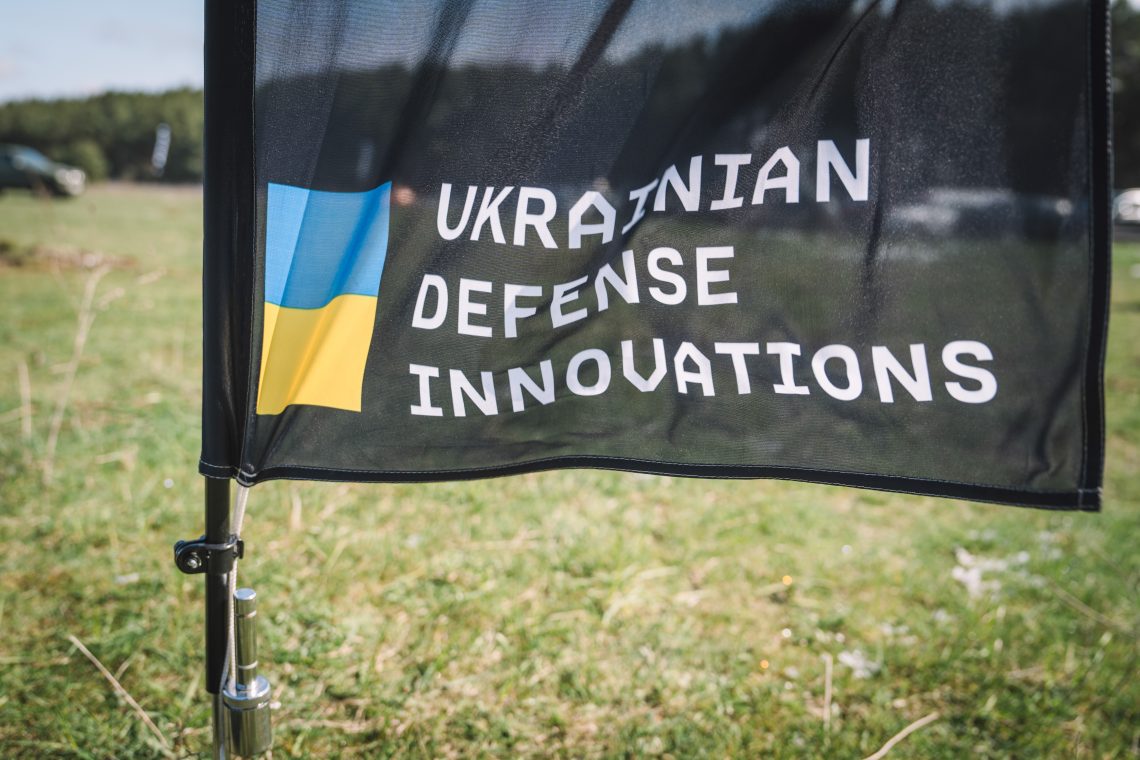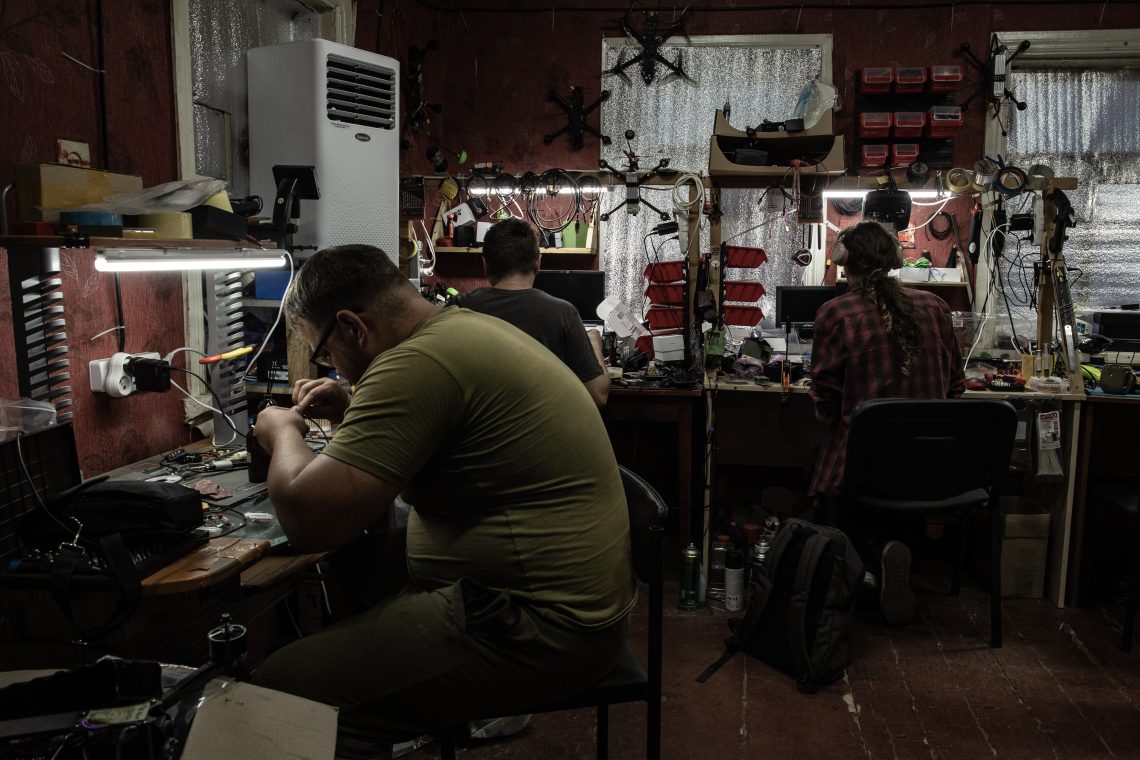Eyewitness to War: Ukraine’s tech hubs and digital Darwinism
Kyiv’s resilience against Moscow’s war machine stems from a decentralized, digitally fluent innovation culture driving rapid battlefield adaptation.

In a nutshell
- Dispersed tech hubs enable experimentation and frontline-driven innovation
- Digital fluency transforms civilian expertise into wartime solutions
- Ukraine’s decentralization challenges traditional procurement paradigms
- For comprehensive insights, tune into our AI-powered podcast here
This is another installment of the series “Eyewitness to war” by Dr. Paul Schwennesen, who writes firsthand observations from the Ukrainian front lines.
Ukraine’s continuing resistance to Russian aggression is an accomplishment that deserves greater analytical scrutiny than it currently receives. After nearly four years of sustained conflict (longer than the United States fought Nazi Germany in World War II, by way of comparison), this startling fact is often assumed as a given or explained away by generalizations about “Western support.”
While allied support has been substantial, to be sure, the West’s unpredictable backing has prompted a massive, society-wide resistance culture in Ukraine, which now produces technological breakthroughs at an astonishing pace. The essential features of this resistance are Ukrainian, not Western.
A key ingredient enabling Ukraine’s war effort to keep its edge is the country’s highly decentralized, evolutionary “tech hub” culture – an ecosystem of small-scale entrepreneurial ventures scattered around the country responding to operator feedback rather than defense ministry directives. It is messy, scrappy and lacks coherence to outside observers, but it works.
R&D dispersal and acceleration
My first impression, stepping into a provincial Ukrainian town, was that I had been dropped at the wrong location. The building in front of me looked like any other nondescript Soviet-era hotel that had limped into the post-Soviet age. Its stucco facade was flaking, and the concrete walkways were cracked. If I had not met the hub’s director on the street corner, I would have walked past without a second glance.
And yet, here I found another example of the remarkable nerve centers that power technological innovation in modern warfare. The building’s second floor was gutted and reconfigured into a series of open-space workstations, each crowded with laptops, 3D printers, soldering irons and disassembled drones. The faint smell of ozone and tea set the tone. Power cables snaked across the floor, connecting clusters of engineers to messy stacks of servers in the corner.
The location was no accident. By dispersing their operations in plain sight, blending into the ordinary fabric of civilian infrastructure, Ukrainian innovators both protect themselves from attack and create conditions in which their work can continue without the formality, rigidity – and vulnerability – of centralized state facilities.
It is easy, sitting in a Western capital, to imagine the war industry as the domain of heavily fortified defense complexes, with vast budgets and layers of hierarchical bureaucracy. What I witnessed in Ukraine was the opposite: small, agile groups of technicians, programmers and hobbyists occupying forgotten corners of ordinary real estate refashioned into workshops of war. The very banality of their chosen sites – abandoned office buildings, unused schoolrooms, retrofitted hotels – makes the military research and development hubs nearly invisible to Russian reconnaissance and domestic informants.
These teams are unhindered by cumbersome safety protocols, and instead see every munition as a fungible resource to be shaped to their particular need.
This dispersal is not only geographical, but intellectual as well. Each location is a self-contained entity, pursuing projects at various stages of readiness, without waiting for a central authority to dictate priorities. One corner of the floor worked on integrating a new artificial intelligence-based targeting algorithm into a first-person view (FPV) drone. Across the hall, a team was soldering together prototypes of low-cost, expendable loitering munitions. In another room, a group debated coding fixes to ensure ground-control stations could switch seamlessly between drones in the air. At any given moment, a dozen projects competed for attention, resources and ingenuity. The sheer simultaneity of invention was disorienting.
The “bespoke munitions” approach makes custom-built drone explosives from scavenged battlefield munitions. These are developed along exactly the same principles of accelerated, real-time research and development. Enterprising battlefield technicians find, defuse and refashion standard-issue munitions like anti-tank mines into smaller, better-tailored drone payloads deployed in specially printed casings. These teams are unhindered by cumbersome safety protocols, and instead see every munition as a fungible resource to be shaped to their particular need. They have taken the “Reduce, Reuse, Recycle” mantra to a new level. It is risky, but the brainstorming developers are intentional: they understand their tolerances keenly, and constantly balance safety and utility.
This do-it-yourself approach to munitions build-out follows the dispersal theme closely: when individual units construct their own munitions, the opportunity for Russian forces to target centralized weapons depots (as the Ukrainians have done) is significantly hampered.
Ukraine’s tech decentralization
The Ukrainian defense ecosystem today is characterized not by top-down direction but by radical decentralization. This is both a necessity and a strength. The defense ministry, like any national bureaucracy, struggles to adapt quickly, and it strives to extricate itself from decades of corruption-leaning tendencies. Procurement processes are bogged down in paperwork; approvals must be routed through multiple offices; standards are debated long after they have been outpaced by battlefield reality. But the frontline war does not pause for procurement.
It is here that Ukraine’s grassroots tech culture fills the void. Start-ups, informal design bureaus and volunteer-driven workshops respond directly to operator feedback, often with relatives and friends on the front line through direct messaging apps like Signal and Telegram. An engineer may receive a message from the front in the morning – “we need beefier ground drone steering actuators,” for example – and by the afternoon, they are testing new designs in the courtyard.
During my latest visit, one engineer proudly demonstrated a newly developed flight control module. The unit has built-in Trusted Platform Module (TPM) firmware protection, so if caught by the enemy, it cannot be copied.

This direct feedback loop – operators to engineers, engineers back to operators – overcomes the slow crawl common in official channels. The result is an evolutionary arms race fought at the micro scale. Some innovations fail; others succeed spectacularly. The essential realization is that failure is not the end. Unlike in traditional defense industries, where years of planning and billions of dollars are at stake, here the sunk cost of experimentation is low. A prototype drone costing $500 can be tested, lost, redesigned and redeployed within days.
The hub I visited typically has between 10 and 20 projects in the pipeline at any one time, each at a different stage on the technical readiness spectrum. Some were at the conceptual stage – sketches on whiteboards, algorithms running in simulation. Others were fully deployable units being boxed for shipment to frontline brigades. The fluidity with which teams shifted resources among these projects was striking. If a battlefield report downgraded the utility of one approach, attention would pivot elsewhere without much sentimentality. In the West, where careers and contracts ride on single programs, such nimbleness is rare.
I was reminded of the Silicon Valley ethos of “fail fast, iterate often.” But here, the stakes are life and death. This urgency lends a seriousness to even the most improvised tinkering. A set of canister munitions lay stacked in a corner – to be used, no doubt, in some future scheme. A programmer debugging code understands that a mistyped line could mean a lost drone, and potentially a lost operator. The gravity of war channels the anarchic energy of innovation into a focused stream.
Digital competency is key to the war effort
If dispersal and decentralization are the structural features of Ukraine’s tech ecosystem, digital competency is its underlying principle. What struck me most forcefully was not simply the abundance of technical skill, but the cultural immersion in digital fluency. From gas station transactions to cutting-edge deep strike platforms, Ukrainians are more comfortable and adept in rapid digital transfers than many in the West, and certainly more than their Russian adversaries.
Many of the engineers and technicians I met are under 30 years of age. They have grown up in a country where information technology outsourcing has been a major economic driver. Ukraine, since long before the war, has cultivated a highly educated, digitally savvy workforce fluent in coding, open-source collaboration and rapid prototyping. When Moscow brought its war to the Ukrainians, this reservoir of human capital pivoted toward defense overnight.
It is not just technical skill, but a digital culture that distinguishes Ukrainian resistance. Workspaces are flat hierarchies; GitHub repositories (cloud storage for code, files and revision histories) circulate patches and schematics; Telegram channels coordinate logistics in real time; targeting choices are discussed via Discord. “We are more like a hacker collective than a military contractor,” one developer said. Yet the results rival those of billion-dollar Western defense firms.

Take, for instance, the integration of AI into targeting systems. While Western governments debate the ethics and legality of autonomous weapons, Ukrainian coders pragmatically write algorithms that assist operators in faster object recognition, reducing cognitive load and improving strike precision. These systems are not theoretical – they are flying and striking today.
Equally telling is the way Ukrainians leverage global open-source platforms and commercial technology. One team showed me how they had adapted code from a civilian drone enthusiast forum, modifying it for encrypted battlefield communications. “Why reinvent what is already shared?” they asked. This spirit of borrowing, adapting and redeploying digital tools makes the tech hub ecosystem astonishingly efficient.
This is not to suggest everything is a glittering digital paradise – far from it. The gritty reality of day-to-day survival is also defining: oil-stained mechanic shops, bullet-riddled supply vehicles and dirt-under-the-fingernails trench life operate in tandem with this tech hub culture. Some compare it to living partly in World War I and partly in Terminator III. The hotel I visited was wired into a broader constellation of similar tech hubs. Designs tested in one city are often uploaded, refined and implemented elsewhere. Failures are documented in shared chats; successes are rapidly copied and iterated. It is a form of digital Darwinism: the fittest ideas survive and spread with astonishing speed.
Lessons for modern warfare beyond Ukraine
What I witnessed in that unassuming hotel challenges deeply ingrained assumptions about how military innovation can and should occur. Western defense establishments are accustomed to vast, centralized programs, long timelines and rigid procurement hierarchies. Ukraine − out of sheer necessity − has demonstrated that dispersed, decentralized, digitally fluent networks can out-innovate traditional structures, especially under the pressure of existential conflict.
Ukraine’s system is not without its flaws. The very messiness that fuels innovation can make coordination difficult; some efficiencies are certainly lost in the friction of competition. Resources are sometimes duplicated; breakthroughs can still be lost in the noise. Moreover, reliance on volunteerism and improvisation probably cannot scale in peacetime. Still, the fact remains: Ukraine has sustained itself against a numerically superior adversary for nearly four years, in no small part because it has embraced this distributed model of war-making innovation.
Read more on Ukraine
- Ukraine needs support now
- Ukraine as an energy hub for Europe
- If Russia and Ukraine make peace, Turkey can help sustain it
There is a cautionary lesson here for the West. If it continues to imagine that large, monolithic defense programs will automatically deliver superiority, it risks being outpaced by adversaries who are forced to innovate under duress. The future of warfare may look less like a polished defense contractor’s showroom and more like the inside of a retrofitted hotel, humming with 3D printers, servers and the improvised genius of 20-somethings who refuse to go to sleep.
In that sense, the greatest lesson of Ukraine’s tech hubs is not technical but cultural. Liberty, resilience and ingenuity – applied in a decentralized, digitally competent fashion – can be an astonishingly effective deterrent force. The message is unmistakable: Ukraine’s tech hubs are what resistance looks like in the digital age.
Scenarios
Least likely: Ukraine’s tech network withers, Russia gains the upper hand
Ukraine’s dynamic digital culture, witnessing a dramatic decline is a conceivable though unlikely scenario. The elements of adaptive culture are too diffuse, and too ingrained for any single factor to substantially degrade Ukraine’s tech hub ecosystem. But if it were to implode, the reduced innovation base would almost immediately lead to battlefield losses at the front.
Russian engineers (aided by their Chinese, Iranian and North Korean allies) would quickly accelerate into the leading edge of the innovation envelope, fielding technologies that would confer an insurmountable advantage.
More likely: Russia attempts to knock Ukrainian innovation offline
It is possible to envision Russian strategists delivering a significant military blow aimed at the electric lifeblood of Ukraine’s strategic developmental network. A theater-level electromagnetic pulse (for example, an air-detonated nuclear device over Russian territory to avoid international escalation), or a sustained campaign against power-grid or cell networks, would have an outsized impact on the rapidity and flexibility of Ukraine’s digital ecosystem. Such blackouts could have a substantial impact on the developer-user loop, degrading Ukraine’s ability to iterate and innovate in near real-time.
Most likely: Moderate centralized consolidation of Ukrainian tech hubs
If history is any guide, significant efforts will likely be made by Ukraine’s defense ministry in the rational pursuit of “efficiency” to consolidate the tech hub sector and centralize development efforts under more unitary control. Some of this has already been seen with the concentration of up to one-third of the defense drone budget into one company (Fire Point, developer of the “Flamingo” cruise missile). This concentration has garnered increased scrutiny from the National Anti-Corruption Bureau of Ukraine. Warranted or not, the level of concentration and attendant oversight will have short- and long-term consequences and will likely sap a marked degree of the innovative energy from within the design sector.
So said, many within the Ukrainian political and defense establishment recognize the inherent advantages in their decentralized approach and are unlikely to support excessive consolidation – a relative balance will undoubtedly be reached between laissez-faire innovation and rigid defense contracting.
Contact us today for tailored geopolitical insights and industry-specific advisory services.





